Posted by Elena del Valle on July 11, 2022

Mathieu Champigny, group chief executive officer, CoCreativ
Photo: CoCreativ
A podcast interview with Mathieu Champigny, group chief executive officer, CoCreativ, is available in the Podcast Section of Hispanic Marketing and Public Relations, HispanicMPR.com. During the podcast, he discusses brand versus product messaging with Elena del Valle, host of the HispanicMPR.com podcast.
Mathieu has held a number of high tech and creative management positions in Europe and the United States over the past 20 years. In his current role he leads Industrial Color, Globaledit and Smashbox Studios servicing brands in creative production solutions. Before managing this creative group of agencies, his career started in structured finance in Paris, France followed by Houston, Texas.
To listen to the interview, scroll down and click on the play button below. You can listen by looking for “Podcast” then select “HMPR Mathieu Champigny” and download the MP3 file to your audio player. You can also find it on the RSS feed. To download it, click on the arrow of the recording you wish to copy and save it to disk. The podcast will remain listed in the July 2022 section of the podcast archive.
Posted by Elena del Valle on April 6, 2022
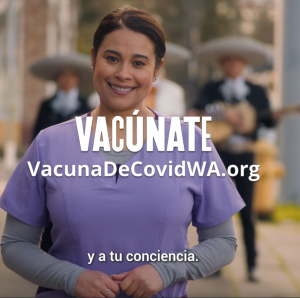
Washington Hispanic market campaign videos link to VacunaDeCovidWA.org
Photo: Tony Teran
Video: Washington State Department of Health
Hoping to reach Hispanics between 18 and 35 years of age hesitant about pandemic vaccines in Washington state with a pro Covid-19 vaccinations message the Washington State Department of Health hired C+C. The Seattle-based marketing agency produced audio and two video spots in Seattle. Production costs for Vacúnate Mijo/a were $168,000 and $205,000 for Mentira Mariachi. The ads were produced for broadcast distribution, YouTube, TikTok and radio. Scroll down to watch videos in English and Spanish (with subtitles).
When C+C conducted the initial research that led to the campaigns’ development, the team found that while most Hispanic people in Washington state were “very willing or somewhat willing” to take a Covid-19 vaccine more English-speaking survey respondents expressed vaccine hesitancy than Spanish speakers. Overall, 62 percent of survey takers said they were very willing or somewhat willing to receive a Covid-19 vaccine; 67 percent of Spanish speakers and 56 percent of English speakers said they were very or somewhat willing to get vaccinated; 2 percent of Spanish speakers who responded to the survey compared to 18 percent of English speakers who responded to it said they would not take the vaccine; 27 percent of Spanish speakers versus 23 percent of English speakers who answered questions said they were unsure; more English speakers than Spanish speakers said they thought Covid-19 vaccines may be unnecessary and ineffective; and more English speakers than Spanish speakers said they had other ways to protect themselves against the virus.
According to a C+C spokesperson the overall goal of the campaigns was “to increase vaccination rates among the Hispanic community in Washington by tackling key research findings. Misinformation on vaccine safety and efficacy was indicated as one of the main drivers of vaccine hesitancy among this community. While protecting themselves, their loved ones, and their community ranked as the main motivation for getting vaccinated.”
The agency addressed concerns about trust in the vaccines with emotional pleas to family ties, Spanish language and Mariachi music. Tony Teran, campaign writer and creative director, C+C, replied by email via an intermediary, “At the center of the Vacúnate Mijo/a campaign is the relationship between a grandchild and a grandmother or abuela, a much loved and nostalgic figure among many Hispanic/Latinx families, often seen as a trusted voice of reason. We follow their bond through different life stages that showcase the core of our message: protecting each other. The Spanish language is also a powerful connecting thread in these ads, as we hear the word mijo/a express different emotions at different times, a word so simple, yet incredibly purposeful. Abuela is saying ‘I care about you’ with every mijo and ultimately encouraging her grandchild to receive the vaccine.
The idea behind the Mentira Mariachi campaign is that we all listen to the voice of our conscience when making decisions. So, what if that voice came accompanied by trumpets and guitarrón, as in traditional Mariachi music, to remind audiences to listen to science and their good judgement, and not to misinformation? The :30 video spot shows a young guy at home. Every time he is exposed to fake news about the COVID-19 vaccines, he’s surprised by a Mariachi band popping out of nowhere to humorously remind him, with a catchy jingle, that those are mentiras (lies). At the end of the spot, we see him coming out of a vaccination site after getting his shot as Mariachi band members give him a nod of approval and a health care worker delivers the campaign’s tagline: ‘Escucha a la ciencia y a tu conciencia.’ (Listen to science and to your conscience.)”
The Vacúnate Mijo/ ad goal was to encourage community members to get vaccinated by emphasizing the importance of protecting their loved ones during the pandemic; while the Mentira Mariachi ad was meant to dissipate vaccine misinformation by encouraging the audience to “trust science.”
According to information provided by C+C the Hispanic population in the state represents 13 percent of the total population, yet in mid-July 2021, had 27 percent of the coronavirus cases, 19 percent of total hospitalizations, and 8.4 percent of total deaths in Washington; about 60 percent of the state’s Hispanic population remained unvaccinated, according to the Washington Department of Health.

Tony Teran, creative director, C+C
“Creative concepting for both of the campaigns began in August 2021,” Teran replied when asked how many months the campaign project required. “Vacúnate Mijo/a launched in November 2021 while Mentira Mariachi launched in February 2022.
The C+C team used three different types of research when developing the strategy and concept for this Hispanic/Latinx-focused campaign: 1:1 Interviews, since 2020, the team has been conducting monthly 1:1 in-depth interviews with Hispanic/Latinx community members to learn about their overall attitudes, barriers and motivators for getting a COVID-19 vaccine.
Focus Groups, C+C conducted four focus groups with Hispanic/Latinx community members to test the campaign’s creative approach and gain insights into what type of creative would resonate most with the community. A total of 20 community members participated.
Secondary Research, The Washington State Department of Health (DOH) and C+C worked hand-in-hand with partners like the University of Washington’s Latino Center for Health to analyze insights about vaccine hesitancy among the state’s Hispanic/Latinx population that helped shape the campaign, including a report released by the Center in April 2021. The team also referenced findings of COVID-19 surveys conducted regularly by the Bill & Melinda Gates Foundation/Civis Analytics.”
When asked how the agency measured results Teran replied, “We have been correlating the success of the campaigns with the increase in vaccination rates among Hispanic/Latinx adults in Washington. Approximately 63 percent of the Hispanic/Latinx community 18+ in Washington have initiated vaccination as of 3/25. This is up from 49.9 percent in November 2021 before the campaigns launched. This amounts to an increase of 13.1 percent. The overall vaccination gap has also closed by 7.4 percent among the Hispanic/Latinx community. The gap closed on Hispanic/Latinx community vaccination rates from being 29.5 percent behind the overall Washington state rates in November 2021 to only 22.1 percent behind in March 2022.”
The campaigns were developed and produced by a team that included members of Washington state’s Hispanic community, including Terán, the creative of Venezuelan roots behind the original concepts. He wrote the video and audio scripts, and oversaw the campaigns’ production process; featured Hispanic cast member for both campaigns; and the production team selected Spanish speaking talent seeking a cultural fit, and with good acting skills and on-camera presence, according to information provided by C+C.
The Vacúnate Mijo/a production included creative input from Mauricio Valadrian, of Valadrian Creative & Consulting; the Mentira Mariachi video production was co-directed by Marvin Lemus, director of Netflix’s Gentefied, and also a Hispanic creative; the Mentira Mariachi video and audio ads feature an original song written for that campaign by a Hispanic musician and performed on-screen by Tacoma-based Mariachi Ayutla, a mariachi band, according to information provided by C+C.
Mentira Mariachi ad in Spanish
Vacúnate Mijo ad in English
Posted by Elena del Valle on May 3, 2021
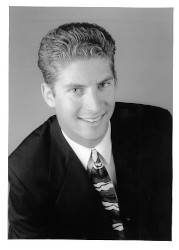
Tony Hereau, vice president of Cross-Platform Insights, Nielsen
Photo: Nielsen
A podcast interview with Tony Hereau, vice president of Cross-Platform Insights, Nielsen, is available in the Podcast Section of Hispanic Marketing and Public Relations, HispanicMPR.com. He discusses podcast insights with Elena del Valle, host of the HispanicMPR.com podcast.
In his job Tony strives to demonstrate the impact that audio has on media investment, marketing execution, and sales outcomes. He has over 20 years of experience in the buying and selling of media, championed the radio reach story via the Total Audience Report, and most recently developed a measurement service for the podcasting industry.
To listen to the interview, scroll down and click on the play button below. You can listen by looking for “Podcast” then select “HMPR Tony Hereau” and download the MP3 file to your audio player. You can also find it on the RSS feed. To download it, click on the arrow of the recording you wish to copy and save it to disk. The podcast will remain listed in the May 2021 section of the podcast archive.
Posted by Elena del Valle on April 20, 2016

Unilever 100porcientotu campaign image
Photos: Unilever
To promote its Personal Care brands among Hispanics on social media Unilever staff launched #100PorCientoTu, a new bilingual campaign designed to promote “self-expression and individuality” in 2016. In developing the campaign executives relied on research from the company’s Consumer Marketing Insights (CMI) team.
Company representatives declined to identify details such as campaign elements or specific channels, except to say that it “will be supported by earned and paid media.” Planned components to date are the sponsorship of Nicky Jam’s The Fenix Tour concert in New York City and the Hispanicize conference in April.
“With #100PorCientoTu, Unilever is merging two Latino passion points, music and style, to inspire Latinos to be their best selves, always,” said Brian Critz, brand director, Multicultural for Unilever U.S. by email forwarded via the company’s public relations company. “At Unilever, we’ve adopted a total market approach to reaching Latino consumers, recognizing that there is a wide range of nuance when connecting with Latinos.”

Brian Critz, brand director, Multicultural for Unilever U.S.
When asked about the target audience for the campaign he said, “With the #100PorCientoTu campaign, we want to celebrate the diversity and dynamism of the Latino community in the U.S., especially among millennials, whose identity is deeply tied to their culture, self-image and aspirations.”
Unilever hired a team of beauty and grooming influencers and experts like Denise Bidot, described as an international plus sized model, and Marcos “Reggae” Smith, described as a celebrity barber, and Leonardo Rocco, described as a celebrity stylist, to provide their views on beauty and grooming trends and tips at the campaign’s English language website, 100PorCientoTu.com. Some of the company’s Personal Care brands are Axe, Dove, Suave, Pond’s, TreSemme, Degree and Caress.
According to a recent company press release, Unilever is a leading supplier of Food, Refreshments, Home and Personal Care products with sales in more than 190 countries and reaching 2 billion consumers a day. In the United States, some of its brands are: Axe, Ben & Jerry’s, Breyers, Caress, Clear Scalp & Hair Therapy, Country Crock, Degree, Dove personal care products, Fruttare, Good Humor, Hellmann’s, and I Can’t Believe It’s Not Butter!; Unilever employs approximately 8,000 people in the United States; and in 2015, the company generated more than $8.5 billion in sales.
Posted by Elena del Valle on December 2, 2013

The Indio billboard by Arturo – click to enlarge
Photos: Heineken USA
Heineken owned beer brand Indio marketers created a billboard campaign to reach target consumers, bicultural Hispanic millennials 21 years of age and older “who consider themselves to be original individuals and place an importance on expressing themselves through everything they do, whether it’s art or music.” They invited artists in several states to submit art around an Indio bottle theme to compete. At the conclusion, a few winners had their artwork displayed on billboards as part of the campaign.

The Indio bottle

The Indio billboard by Saul
Company representatives promoted the Indio Gallery campaign across digital media, with heavy emphasis on Facebook. The brand’s Facebook page (Facebook.com/IndioBeer) was the primary gate for consumers to submit their Indio themed artwork. Each entry from among the hundreds of submissions was judged on creativity, originality, composition and inclusion of Indio brand imagery such as the Indio logo or colors.

The Indio billboard by Benjy

The Indio billboard by Ignacio
Nine artists were invited to participate in the campaign. Inspire, Indio’s Dallas advertisement agency, developed 47 billboard ads with the artwork. MediaVest’s MV42, the brand’s media agency, placed them.
Each artist is credited for his work on the billboards, which feature their name and hometown, as well as the brand’s tagline, beer bottle and Facebook address.
The billboards were on display for four weeks in the Chicago, California, and Texas markets in October 2013. Grand Prize winner Arturo Rios received a $5,000 cash prize.

Gustavo Guerra, brand director, Tecate, Indio and Bohemia brands
“Public relations efforts generated coverage across media consumed by our target, while our panel of judges promoted the contest amongst their networks via social media and flyers,” said Gustavo Guerra, brand director, Tecate, Indio and Bohemia brands, by email, in response to questions about promotion and coverage. “We looked at the number of entries we received, as well as engagement on our Facebook page and paid media.”

Indio billboard by Nasim

Indio billboard by Ricardo
The judges, who were compensated for their time, were Gil Cerezo (the lead singer of Mexican band Kinky), Diana Garcia (a Mexican illustrator and actress), Federico Archuleta (an Austin street artist), Juan Angel Chavez (a Chicago artist), the president of the National Museum of Mexican Art in Chicago, and the Indio brand team. The Indio Gallery contest was open to residents of California, Texas and Illinois, the states in which the company launched Indio in 2012. Indio is also distributed in Phoenix and Las Vegas. The resulting billboards were placed across key cities in those markets in October 2013.
Indio is imported from Mexico. A company representative declined to disclose the number of bottles sold in the United States per year or the percent of the Hispanic market segment among fans of the beer brand. Launched in 1893 under its flagship brand, Cuauhtémoc beer, the label featured an Aztec emperor. Consumers nicknamed it the “beer of the Indian.” This led to the current name, which is Spanish for Indian, in 1905.
Posted by Elena del Valle on November 5, 2012

Kevin O’Shea, brand manager, Gold Eagle Co.
Photo, video: Gold Eagle Co.
Gold Eagle Company released Chainsaw Psycho, a national television and online ad, a spoof of the 1974 cult chainsaw massacre movie, to promote its brand of fuel-system revitalizers, Start Your Engines! Shot in Conestogo, Canada and produced in one week by five people under the supervision of Matthew Ninaber, a Poptent community member, and his team at High-Rise Studio in Ontario, the ad was designed for a target audience “not limited to but mostly for men” and “people with a sense of humour.” Scroll down to watch the ad video.
“We wanted to do something entirely different with this TV spot to illustrate how Start Your Engines! works and overemphasize its immediate solution to those untimely life moments when your small-engine equipment malfunctions,” said Kevin O’Shea, brand manager, Gold Eagle Co. “This TV spot also marks an exciting new direction for Gold Eagle’s marketing approach.”
In the Halloween-themed spot a chainsaw killer is about to take his next victim only to discover his chainsaw won’t start. The victim, lying on the floor awaiting his doom, gives the killer advice for small engine trouble shooting and offers the killer a bottle of Start Your Engines! The spot concludes with the victim extolling the benefits of the product just before the chainsaw starts.
The commercial appeared on YouTube and aired on national television in October 2012 on HGTV shows, Property Brothers, House Hunters International and Yard Crashers, and the DIY network on Yardcore, House Crashers and The Vanilla Ice Project. Marketing executives for the company estimate landing page traffic went from nothing to 692 views between September 1 and October 28 of this year. YouTube analytics, a spokesperson shared, indicate that viewership of the spot was just under 23,000 views. Gold Eagle Co. is a privately held Chicago based maker of engine maintenance fluids and fuel additives.
Posted by Elena del Valle on August 1, 2012

New York International Latino Film Festival 2012 Serial Killer Movie Recipe ad – click to enlarge
Video, photos: Wing
Hoping to reach New York City Urbanites between the ages of 25 and 45 the 2012 HBO New York International Latino Film Festival (NYILFF) with the pro bono help of Wing, a marketing communications agency, launched a print and television ad campaign aimed at broadening the appeal of the NYILFF, running August 13-19, 2012 in New York City. Scroll down to watch a 30-second video ad for the 2012 campaign.
“The overall reach of the campaign has been far. We have been picked up by a great deal of pubs including Creativity, TrendHunter, Ihaveanidea.com, Latinspots, Ads of the World, among others,” said Marieugenia Cardenas, assistant account executive, Wing.
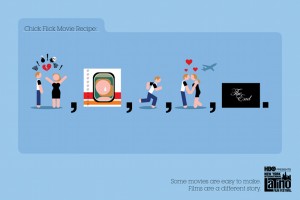
New York International Latino Film Festival 2012 Chick Flick Movie Recipe ad – click to enlarge
Thirteen people under the supervision of Tania Salter, vice president and head of Production at Wing, worked on the campaign this year producing six print ads and two television spots. Some ads ran as public service announcements and some as paid advertisements in theaters. To date ads have aired on NBC, Telemundo, and Clearview Cinemas.
The campaign, in English and Spanish, pokes fun at Hollywood cliches, relying on the tagline “Some movies are easy to make. Films are a different story.” The stereotypical Hollywood movie types the campaign makes fun of are: Sports Comeback, Serial Killer, Chick Flick, Buddy Cop and Alien Invasion themes.
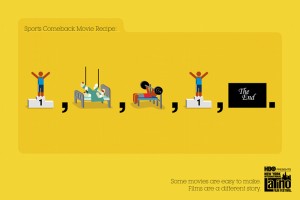
New York International Latino Film Festival 2012 Sports Comeback Movie Recipe ad – click to enlarge
“We were trying to attract people who normally don’t go to this festival (who don’t necessarily speak Spanish) while at the same time not alienating the core audience (who does speak Spanish),” said Cardenas.
This is the second year the festival is partnering with Wing. Last year the campaign poked fun at Hollywood movies for casting Latinos only in roles like maids, gardeners, and fruit stand vendors (see With video NY Latino Film Festival ad campaign makes fun of Hollywood cliches).
According to promotional materials, the campaign went viral through earned media, becoming the top story on Trendhunter and Buzzfeed, and garnered 29 million impressions. Dating back to 1999, the NYILFF strives to showcase the work of emerging Latino filmmakers in the United States and Latin America.
Posted by Elena del Valle on February 15, 2012
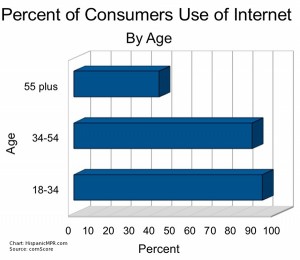
Percent of consumers use of the internet by age – click to enlarge
Marketers targeting Millennial women (those born between 1981 and 2000), should be aware that the members of this generation of 79 million tend to have short attention spans and are more likely to engage with digital media than television, according to Next-Generation Strategies for Advertising to Millennials, a 17-page report by comScore released January 2012. Overall, 93 percent of consumers aged 18 to 34; 88 percent of consumers 35 to 54 and 42 percent of consumers 55 and older said they used the internet, according to the comScore researchers.
It seems the engagement of this generation of women is stronger for digital media than that of older generations who engage more with television, according to the findings of the study. Given the right reasons and a strong incentive from an ad they, like other generations, respond with high ad effectiveness scores.
The results outlined in Next-Generation Strategies for Advertising to Millennials were gleaned from an analysis of nearly 1,000 comScore tests of the effectiveness of television ads and 35 tests of digital creative that aired in the United States. Ad recall and engagement were included in the study.
Overall, researchers examined the views of 500,000 women from four generational groups: Millennials (aged 16 to 29); Generation X (aged 30 to 44); Baby Boomers (aged 45 to 59); and Seniors (60 and older). Only women, considered the primary purchasers for most products, were studied.
Posted by Elena del Valle on November 9, 2011

Juan Motta, head, Nestlé’s Emerging Markets
Photo: Nestlé USA
Executives at Swiss owned Nestlé want to reach Spanish dominant Hispanics in the United States with Construye el Mejor Nido (Spanish for Create the Best Nest), a new communication platform that offers Nestlé’s nutrition, health and wellness resources to Spanish speakers. The program was announced at the end of September 2011 in time to mark the year’s Hispanic Heritage Month.
According to promotional materials, elements of the program, which marks several firsts for the company, include efforts on Spanish language television, Facebook, a bilingual website, in store marketing, and product sampling packs. It is the first time the company launches an integrated multi-brand platform for consumers and shoppers in the United States; the first time Nestlé USA plans a corporate branded TV campaign; the first time Nestlé iconography of the nest concept is leveraged as a concept domestically; and the first time Nestlé USA plans to leverage its equity and drive associations between the Nestlé brand and individual brands.
The company released three television ads designed to demonstrate how Nestlé products “fit into Hispanic consumers’ everyday life and help them to nurture their family’s lives.” The ads are also designed to leverage and reinforce Nestlé’s iconography of the nest in the Nestlé corporate logo which executives hope conveys family, trust and well-being to Hispanics.
“Hispanic Heritage Month is the perfect time for Nestlé USA to reaffirm its strong history of awareness, trust and expertise among Hispanic consumers,” said Juan Motta, head, Nestlé’s Emerging Markets. “This awareness and trust stems from a strong emotional connection with authentic Nestlé brands in consumers’ home countries such as Nescafé, Abuelita, Nido and La Lechera. Construye el Mejor Nido provides consumers with information on familiar brands, as well as with other Nestlé brands available in the U.S. such as Juicy Juice and Stouffer’s.”
Believing that Facebook reaches 98 percent of Hispanic women 35 to 49 who go online Nestlé USA established Facebook.com/ElMejorNido. The page, which features contributions from Hispanic bloggers, is meant to provide a brand and cultural connection, and a place where visitors can share recipes and tips. To further its online reach the company established ElMejorNido.com, a bilingual website that promises blogger contributions, tips, articles, food videos and information on wellness, culture and parenting. The site also offers Nestlé the means to build a marketing list by providing visitors the option to receive information from the company.
Construye El Mejor Nido, an in-store effort, was designed to reach Hispanic shoppers in independent and mainstream stores through in-store circulars, bilingual door hangers, and recipe booklets. Nestlé plans to introduce new products and connect with Latino consumers by providing Fiesta Packs with new products, recipes, and party supplies to select Hispanic families. The company’s promotional materials indicate the Construye El Mejor Nido program has been well received by consumers, with traffic to the website and Facebook page exceeding expectations.
Posted by Elena del Valle on August 15, 2011
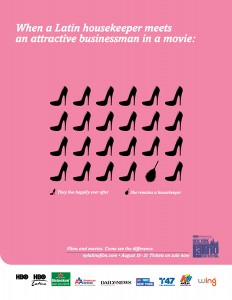
NYILFF Wing 2011 ad – click to enlarge
Photos, video: Wing
Hoping to attract English speaking New York City residents between 25 and 45 years of age to its twelfth annual event the organizers of the 2011 New York International Latino Film Festival (NYILFF) launched a new ad campaign the first week of August created to highlight a difference between movies and films by ribbing Hollywood movie cliches. The campaign with an estimated $50,000 in production costs and as much as one million dollars in paid and pro bono placements, was shot in Argentina with post production work in the United States. Scroll down to watch an ad.
The campaign emphasizes the shortage of Latinos in mainstream movies as well as the idea that Latino films concentrate on life compared to the “larger than life” abundant in blockbusters by showcasing stereotypical concepts like: The number of shots a six-round revolver can take in a movie without reloading, what happens in movies when a Latina housekeeper meets an attractive businessman, the names of gardeners in movies, and what happens in horror movies when a girl tries to get in a car.
TV and in-cinema ads, titled Asteroid, Dynamite, Fruit Stand Guy and Man in the Mirror, were produced by Wing, a New York ad agency, on a pro bono basis with the help of Academy Award winning Argentinean Production Company Puenzo Hermanos. The film festival staff believe the event’s audience consume a variety of media and love New York “for its energy and for everything it has to offer” and “define themselves as adventure-seekers and search out new and interesting experiences to fill their social calendar.”
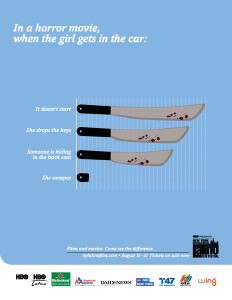
NYILFF Wing 2011 ad – click to enlarge
Each spot in the 2011 campaign makes fun of stereotypical Hollywood movie characters and ideas, and includes the tagline “Films and movies. Come see the difference.” In addition to TV, there are eight print and out-of-home ads in English and Spanish. The campaign seeks to reach “a broader audience with a commentary on the simplistic nature of Hollywood films, rather than an overtly Hispanic approach,” according to promotional materials.
Wing also created agency promotional material in-cinema and print that encourages people to let their Latino out. The in-cinema spot, intended to be “a whimsical and light-hearted effort” that shows an “un-Latin looking thin man” growing a thick mustache and liking it, attempts to emphasize the Hispanic influence on the mainstream market. Fifteen staff, led by Cionin Lorenzo, Elizabeth Gardner, Calixto Chinchilla, dedicated six months to the campaign production the success of which will be measured through ticket sales and on-line views. Festival staff anticipate 25,000 attendees at this year’s events.
The campaign was launched in NBC/Telemundo, HBO, Time, Out New York, Latina Magazine and the New York Daily News. In addition to the ads, the festival has active Facebook and Twitter pages where the new ads have been heavily promoted, a spokesperson indicated when asked about online placement of the ad campaign. The festival website was revised to coincide with the look and feel of the campaign. Also, the film festival independently created banner ads with geo-targeted placement on Hispanic websites. No information was available on which sites exactly.
The New York International Latino Film Festival strives to showcase the works of emerging Latino filmmakers in the United States and Latin America. This year’s festival run August 15-21 in various New York City theaters.
































